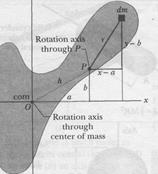Proof of the Parallel-Axis Theorem
 Fig. 11-12
Fig. 11-12
|
Let О be the center of mass of the arbitrarily shaped body shown in cross section in Fig. 11-12. Place the origin of the coordinates at O. Consider an axis through O perpendicular to the plane of the figure, and another axis through point P parallel to the first axis. Let the x and у coordinates of P be a and b.
Let  be a mass element with the general coordinates x and y. The rotational inertia of the body about the axis through P is then, from Eq. 11-28,
be a mass element with the general coordinates x and y. The rotational inertia of the body about the axis through P is then, from Eq. 11-28,

which we can rearrange as
 11-30
11-30
From the definition of the center of mass (Eq. 9-9), the middle two integrals of Eq. 11-30 give the coordinates of the center of mass (multiplied by a constant) and thus must each be zero. Because  is equal to
is equal to  , where
, where  is the distance from О to
is the distance from О to  , the first integral is simply
, the first integral is simply  , the rotational inertia of the body about an axis through its center of mass. Inspection of Fig. 11-12 shows that the last term in Eq. 11-30 is
, the rotational inertia of the body about an axis through its center of mass. Inspection of Fig. 11-12 shows that the last term in Eq. 11-30 is  , where
, where  is the body's total mass. Thus, Eq. 11-30 reduces to Eq. 11-29, which is the relation that we set out to prove.
is the body's total mass. Thus, Eq. 11-30 reduces to Eq. 11-29, which is the relation that we set out to prove.
Дата добавления: 2015-06-17; просмотров: 687;
